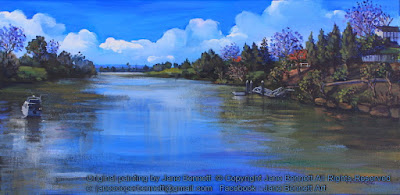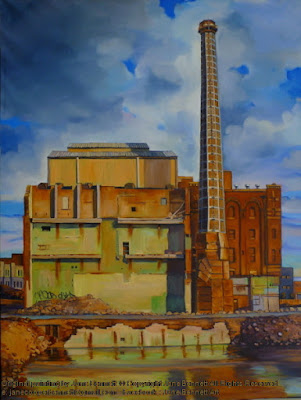 |
| TSWB1 Windsor Bridge from western side 2013 acrylic on canvas 46 x 61cm |
Thompson Square, established in 1795 at the centre of Windsor, is thought to be the oldest public square in Australia.
The old Windsor Bridge was a beam bridge built in 1874 for horse-drawn vehicles.
This canvas was painted in 2013 before NSW Roads and Maritime Services (RMS) department had started work on the replacement bridge, 35 metres (115 ft) downstream from the existing bridge.
The bank on the Freeman's Reach side of the Hawkesbury, where I painted this idyllic view marks exactly where the new bridge is now situated.
I painted these scenes in jacaranda flowering season as the bluish mauves offset the bright greens of the foreground.

TSWB3 Windsor Bridge early morning from western side
2013 acrylic on canvas 46 x 61cm
Available

TSWB12 View from Windsor Bridge in jacaranda season
2015 oil on canvas 25 x 51cm
Available

TSWB3 Windsor Bridge early morning from western side
2013 acrylic on canvas 46 x 61cm
Available
The old bridge is an austere construction with modestly proportioned piers and the engineering of the
cross bracing consistent with the challenges of its location.

TSWB12 View from Windsor Bridge in jacaranda season
2015 oil on canvas 25 x 51cm
Available
As you can see from the painting above, the real charm of Windsor Bridge is revealled in its river vistas.
Monet would have loved this spot. And my gallerist, on seeing these works, did ask if I'd painted them in France.
This
area certainly inspired Arthur Streeton, one of the Australian
Impressionists, who painted his masterpiece "The Purple Noon's
Transparent Might" not far from here.

TSWB16 'Construction of the new Windsor Bridge' 2019
oil on canvas 91 x 183cm
Available
But now the timeless harmony of the sleepy river and the Georgian, Victorian and Federation architecture of Thompson Square has been surrounded by a maelstrom of excavation and construction.
Most of the old trees have now been felled.
The new bridge opened to traffic on 18th May 2020.
The new approach
road rises up on a large visually intrusive embankment as it cuts a swathe
through the square.
There is now a bitter battle to save the 140 year old bridge from demolition. The RMS has stated that it will start removal in the coming months, but many would prefer the old bridge to be restored and left in situ.
Related posts








